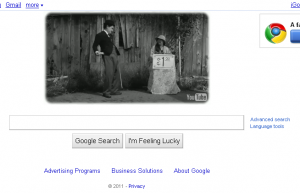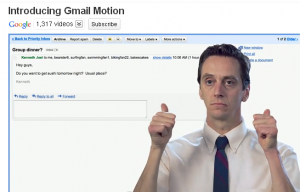Okay let’s just get this out. I’m a big Google fan, user, and customer. I’m also making non-trivial income from Google’s YouTube Partner program (through ad sharing on my Nalts videos seen 200 million gazillian times). So I really hesitate commending the company in a post headline. It looks I’m friggin’ shilling incognito and I hate that crap (see my parody on f’ing buzz marketing).
Instead I prefer to prank, complain and criticize the company to ensure my “checks and balances” are in place. It can border on “biting the hand that feeds you,” but I’ll call it tough love. You don’t own me, bitch (sorry I’ve got an authority issue).
Today’s post, however, is to observe that Google’s brain seems to be developing a frontal lobe (the rather useless part of the brain where insanity and marketing occurs). I’ll be damned if Google isn’t using video (even the YouTube player to keep Salar “Little Superstar” Kamangar happy) in increasingly effective ways. (The marketer rubs little puppy’s tummy and says good boy, as he naively thinks he’s more evolved than a wonderfully blissful animal).
Parenthetically I literally laugh outloud every time I refer to the head of YouTube as “Little Superstar” because I’m aware it appears so completely inappropriate and racist. But I’ll trust you WVFF loyalts will know that if I really felt that way I’d suppress it incredibly well. I stereotype into only two segments: people who make me happy and people who suck away my will to live. Anyway Salar isn’t even Indian he’s Persian or Iraq, and frankly I don’t know the difference or care. I just needed something to use to “downsize” him, since my ego is threatened by him having the coolest job in the world. It was the same thing with Chad, but Chad was a much easier victim since he generally looked stoned.
I wonder if Chad and Samar ever went to Dubai together and ate sushi off of woman’s stomaches.
Okay back to the news. Google using YouTube shouldn’t surprise us at first glance, but put aside Google’s products and branding (it’s hard to do), and ask yourself a question. Do you see Google as a great marketing organization? Or put more succinctly, how well does it tap the advertising medium that feeds it? Right your reaction because I’m coming back to read ’em.
Google historically has done almost no advertising for itself. It kept quiet, muted PR, and rarely showed evidence of advertising/marketing competencies from an external view. Sure, you might credit YouTube took out a Superbowl ad years ago (side note: good luck finding it on YouTube). But I’m convinced that was not for viewers, but simply to sneak access to “Superbowl Buyer’s Man/Boy Club” to pitch well-funded brands on the merits of diverting TV dollars to web.
But now I’m seeing real signs of life. Google print ads with direct-response offers? A discount on Google ads and to encourage app purchases? Really? It’s like watching my son Grant suddenly blossuming academically and reading voraciously. I know I had nothing to do with it, but I’m proud of the double G’s. Sidenote 2: Did I ever tell you I had a clubhouse in my house that I named Google in the late 1970s? Note to self: get time machine, go to 1995 and squat domain name for your childhood clubhouse.
So now the engineering anthill is using video to engage customers and promote? How charming! Let’s review recent and cumulative examples.
1) Branded Entertainment: Today we see a “Google Doodle” (typically an illustration of the logo marking an event) taking video form. The typically clean/sparse homepage features not a small custom image, but an embedded player with a nicely done Charlie Chaplin homage.
 2) Satire/Entertainment: On April Fool’s Day Google pulled its annual prank by rolling out advanced “Gmail Motion” via video. The new solution featured a typical Google product director’s awkward monotone, complemented by a model (Steve Buscemi) demonstrating how physical movements (thumbs up, waves) can be interpreted it into text. One might expect a collective drone if he/she concedes that it was a clever prank, but I liked it. Why? It wasn’t too far fetched, it was executed fairly well, and I interpreted it as a subtle diss on Apple and its self aggrandizing swipes, pinches, and three finger whatevers.
2) Satire/Entertainment: On April Fool’s Day Google pulled its annual prank by rolling out advanced “Gmail Motion” via video. The new solution featured a typical Google product director’s awkward monotone, complemented by a model (Steve Buscemi) demonstrating how physical movements (thumbs up, waves) can be interpreted it into text. One might expect a collective drone if he/she concedes that it was a clever prank, but I liked it. Why? It wasn’t too far fetched, it was executed fairly well, and I interpreted it as a subtle diss on Apple and its self aggrandizing swipes, pinches, and three finger whatevers.

3) Product Launch: Google is increasingly using video to promote and teach out new products (see “advanced gmail” video). Sure Google has been criticized for a somewhat dated approach to product marketing (and some “areas for improvement” in its design/test/launch). But the sheer number of new innovations have me increasing my daily time-share significantly, and I want a Google GPS, Android simulator on my iPhone, and a Google-search brain implant for “just in time” information.
4) Humor: I’m not kidding. You have to look hard, but there’s humor lurking in the hallways. It’s probably like a secret society afraid to draw attention to itself among fellow engineers. But there’s the humanized personification of Google auto-complete (Hiring Autocompleters) that was funnier than its view count would suggest. (Last minute update- I was searching for more examples before hitting post and I remembered I was part of “Demo Slam” to promote additional tools/solutions to a broader audience… now you’re going to think this whole post was motivated by that, and you can kiss my ass because I nearly forgot I did it.
5) Public Relations: Remember all the drama about privacy invasion resulting from Google Earth (buttcrack) and Google Street View pictures? This video that shows “behind the scenes” of Google’s streetview camera vehicle. It replaces the images in my head of a creepy zit-faced MIT intern driving a black van, snapping photos, and wearing no pants.
6) Education & Community: Google uses videos to support community, health education, public service and economic summit Davos whatever… but that’s so damned boring I don’t feel like writing about it.
7) There is No Seven. I just don’t like posts with six items. Actually seven is “reader’s choice.” What’d I miss?

